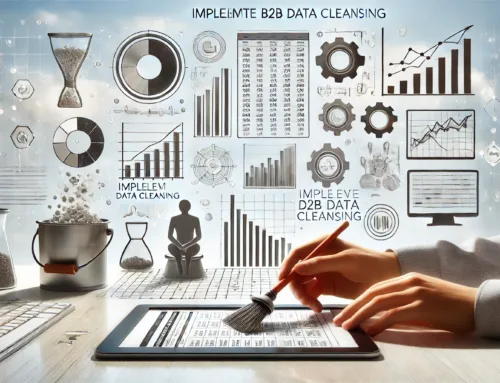To improve B2B data cleansing process, starting with a comprehensive data analysis is key. Identifying discrepancies, eliminating duplicates, and updating obsolete information are foundational steps. Setting specific goals for data validation and duplicate removal allows for progress tracking and performance evaluation. However, there is one crucial aspect often overlooked that can significantly impact the effectiveness of your data cleansing efforts. Curious to find out how to address this critical factor and elevate your B2B data cleansing process to the next level?
Assess Current State
When beginning the process of improving B2B data cleansing, the first crucial step is to assess the current state of your data. Data analysis is key in this phase, where you meticulously examine the quality, accuracy, and completeness of the information within your databases. Through this evaluation, you can identify inconsistencies, duplicates, outdated entries, and other issues that may be impeding the effectiveness of your data cleansing efforts.
Process optimization plays a vital role during the assessment stage. It involves reviewing the existing data cleansing procedures to pinpoint bottlenecks, inefficiencies, and areas for improvement. By streamlining workflows, automating repetitive tasks, and implementing best practices, you can enhance the overall efficiency and effectiveness of your data cleansing process.
Outline Objectives
To effectively steer your B2B data cleansing endeavor towards success, outlining clear and measurable objectives is paramount. Setting objectives focused on data validation and duplicate removal will help you streamline the cleansing process and improve the overall quality of your database. When defining your objectives, consider specific goals such as reducing duplicate records by a certain percentage, ensuring accurate contact information for a specified number of entries, and enhancing data completeness through thorough validation processes.
Measurable objectives provide a roadmap for your data cleansing efforts, allowing you to track progress and evaluate the effectiveness of your strategies. By setting targets related to data validation, you can ensure that only accurate and up-to-date information remains in your database. Similarly, objectives centered around duplicate removal help in eliminating redundant entries, leading to a more efficient and reliable database.
Remember that clear and quantifiable objectives will guide your actions and enable you to measure the success of your B2B data cleansing process accurately.
Define Data Quality Rules
Implementing data quality rules is a critical step in enhancing the accuracy and reliability of your B2B database. By defining clear data quality rules, you ensure that your database remains free from inconsistencies and errors that could affect your business operations. Here are four key aspects to consider when defining data quality rules:
- Data Validation: Establish validation rules to ensure that the data entered into your database meets specific criteria. This includes formats, ranges, and relationships between data fields.
- Error Detection: Create rules that automatically detect errors or inconsistencies within the data. By setting up alerts or validation checks, you can identify and rectify issues promptly.
- Consistency Guidelines: Define guidelines for data consistency to maintain uniformity across all entries. This includes standardizing formats, naming conventions, and data types.
- Data Integrity Rules: Implement rules that uphold the integrity of your data by preventing duplication, ensuring referential integrity, and maintaining data accuracy throughout its lifecycle.
Create a Cleansing Strategy
Crafting an effective data cleansing strategy is paramount to maintaining a high-quality B2B database. To begin, focus on data validation. Implement validation checks to ensure accuracy, completeness, and consistency of the data. This step involves verifying information against predefined criteria, such as formats and ranges, to identify and rectify discrepancies.
Next, prioritize process optimization. Streamline the data cleansing process by defining clear workflows, assigning responsibilities, and establishing timelines. Optimize the sequence of cleansing tasks to maximize efficiency and minimize errors. By standardizing procedures and automating repetitive tasks, you can enhance the overall effectiveness of the cleansing process.
Additionally, consider implementing data profiling techniques to gain insights into the quality of your database. Identify patterns, anomalies, and potential issues that require attention. Regularly monitor and analyze key performance indicators to track progress and make informed decisions for continuous improvement. By integrating data validation and process optimization into your cleansing strategy, you can ensure a reliable and up-to-date B2B database.
Employ Automated Tools
Utilizing automated tools is a crucial component in enhancing the efficiency and accuracy of your B2B data cleansing process. Automated tools can streamline tasks, reduce errors, and ensure that your data is cleaned and maintained effectively. Here are four key ways automated tools can benefit your data cleansing efforts:
- Data Validation: Automated tools can quickly identify and rectify inaccurate or incomplete data, ensuring that your database remains reliable and up-to-date.
- Continuous Monitoring: These tools can continuously monitor your data for any discrepancies, anomalies, or inconsistencies, allowing you to address issues promptly and maintain data integrity over time.
- Efficient Processing: By automating repetitive tasks such as duplicate detection and standardization, you can significantly speed up the data cleansing process.
- Improved Accuracy: Automated tools follow predefined rules and algorithms, reducing the likelihood of human error and ensuring a higher level of accuracy in your data cleansing activities.
Frequently Asked Questions
How Can We Ensure Data Privacy and Security During the Cleansing Process?
To ensure data privacy and security during the cleansing process, you must prioritize compliance with regulations and implement robust encryption techniques. By adhering to strict standards and utilizing encryption, you safeguard sensitive information effectively.
What Are the Best Practices for Handling Incomplete or Missing Data?
When dealing with incomplete or missing data in B2B cleansing, prioritize data enrichment and validation for accuracy. Employ data standardization and normalization techniques to ensure consistency across datasets. These practices enhance data quality and reliability.
How Do We Measure the Effectiveness of Our Data Cleansing Efforts?
To measure the effectiveness of your data cleansing efforts, think of it like baking a cake. Just as you taste-test to ensure perfection, use data accuracy validation and performance metrics analysis for validation.
What Steps Can We Take to Prevent Data Duplication in the Future?
To prevent data duplication in the future, implement robust data validation processes. Utilize automation tools to flag and merge duplicate entries automatically. Regularly audit data sources to ensure accuracy. By combining validation and automation, you can maintain a clean database.
How Often Should We Review and Update Our Data Cleansing Strategy?
You should regularly review and update your data cleansing strategy to maintain accuracy and efficiency. Assess the frequency of review based on data volatility and industry standards. Updating the strategy ensures it aligns with current business needs and best practices.




